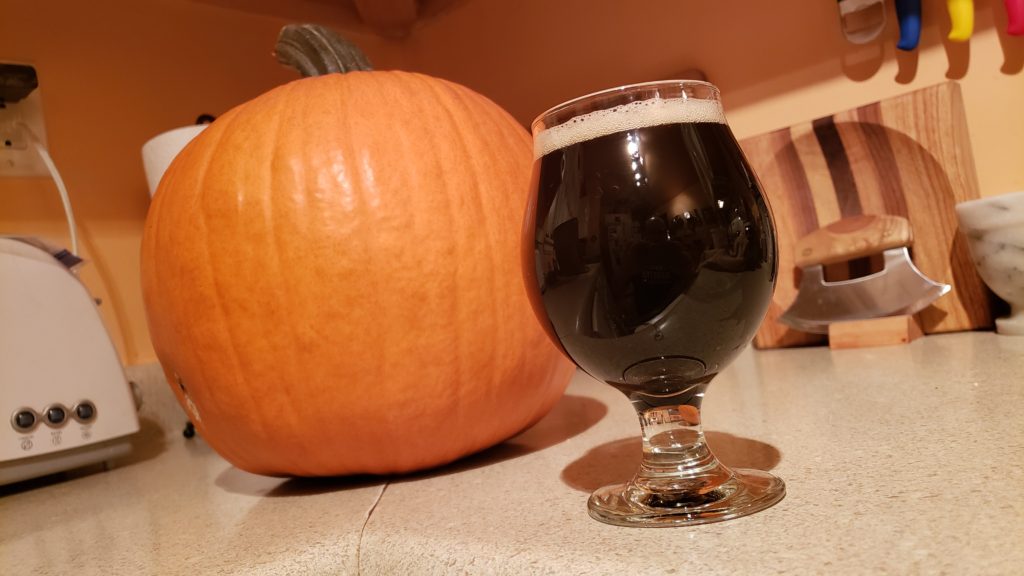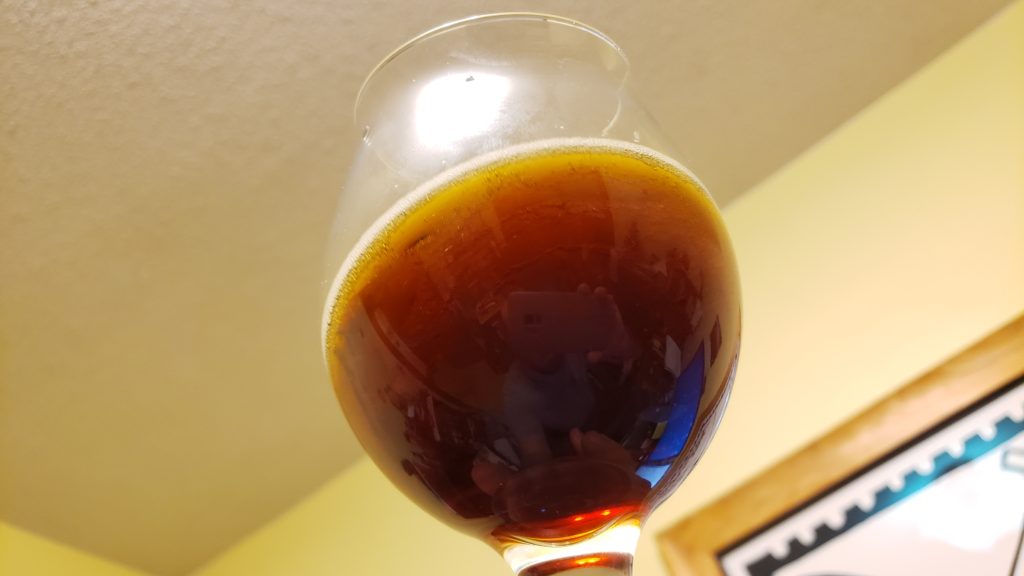Jackolantern’s Weather: Dark Colonial-Era Pumpkin Ale

This recipe post comes from our good friend (and much-appreciated Patreon patron) Paull Illa. His recipe was inspired in part by an article and recipe from Craft Beer & Brewing magazine, Anatomy of a Colonial-Era Pumpkin Ale. It’s a twist on a fall seasonal favorite, a pumpkin beer mashed with roasted pumpkin but without the often polarizing spices so often found in pumpkin beers. As noted in the article, you could add spices like cinnamon, nutmeg, cloves, etc. but we enjoyed this beer much more with just the pumpkin element. Below you’ll find Paul Illa’s introduction to the beer, Chip Walton’s tasting notes, and the recipe. Cheers!
A NOTE FROM PAUL ILLA ON INSPIRATION AND PROCESS
Obviously my inspiration came from 311’s “Jackolantern’s Weather.” I have been a fan for nearly 25 years. No big surprise. Another strange inspiration was driving past a boat load of large pumpkins selling for $3. For some reason it called my name. I happened to run across an article about what a pumpkin beer may have looked like during the colonial days. That brought me to the story of the Headless Horseman in “The Legend of Sleepy Hollow”. Unlike the original article I wanted a larger beer for a cooler time of year, shooting for an ABV of 5%.
The other thing I kept coming back to is the perception of Halloween being a very dark and shadowy time of year. It seemed to me there needed to be a dark element in terms of malt, especially considering the flavors and colors of molasses. Seemed to make sense to play off that. I went with Carafa III without husks. I wanted the color and some of that deep dark chocolate and roast flavor minus a lot of that bitterness from the roasted husk. To minimize that I steeped the dark malt after I pulled the main mash. Kind of like the old extract days. At that time I also added the first wort hops. Two birds, one stone. I did also add a little Munich to the mash to add some of that deep biscuit, toasted bread flavor, plus some additional layers of flavor and boost the maltiness a touch. Briess 2-Row in place of 6-Row more out of availability than need. More wheat to keep pace with a higher gravity. Also makes that pillowy, full head.
Now, 10 pounds of chopped pumpkin IS A LOT. Lots of chopping. I bought a single-use turkey pan. Fired up that gas grill. Filled the bottom with the chunks and baked on the grill, uncovered, for 45 min to 1 hour. Basically until the edges start to brown or darken. I let it fully cool and stored until I needed it in the mash; this helped to soften it more. Just be sure you have a vessel big enough to handle all this pumpkin. I did not add any spices to the boil. This recipe was more about sugars than pumpkin pie flavor, which as noted in the original recipe could be done. I think in terms of effect on the beer it more an herbal like effect than real pumpkin flavor. Hindsight being 20/20, if I wanted MORE pumpkin I could have pureed roasted pumpkin or bought some additional in a can and added to the boil.
I think the beer came together pretty well. I my humble opinion it would benefit from an English base malt, Maris Otter or Golden Promise. You could also forgo the Munich and use Vienna malt. I still think it was successful in terms of results. The Voss yeast can turn the beer fast. You could dry hop in the keg and put on draft in 7 days. I think it did add some of that citrus esters but it is restrained. I was hoping it might show through more but alas it did not. Again, if you have more time, Fermentis S-04 seems more fitting overall. As noted in the article, the Whitbread strain is an old, really well-suited option with solid attenuation and some fruity esters. Homebrewing… where second guessing is the mother of the next brew day.

CHIP’S TASTING NOTES
Aroma: Dark spice, wood, dried herbs, light roast, toast, bit of orange peel.
Appearance: Pours dark brown with off-tan head. Shows nice clarity and garnet highlights against the light. Fluffy head that lasts.
Flavor: Dark malt, dark toast, molasses, licorice/anise, woody, herbal; perhaps the roastiness is coming from the molasses instead of the dark Carafa malts
Mouthfeel: Finishes much drier than you’d expect after a well-carbonated sip. Dryness and bitterness on the back of tongue, anise-y coolness on back of throat.
Impression: In the wheelhouse of a bigger dark mild or less roasty and herbal porter but with some dark fruit and molasses notes.
THE RECIPE
For 5 gallons
No-Sparge BIAB (Based on 55% eff BIAB)
OG: 1.048
FG: 1.010
ABV: 4.98%
Ingredients
Malt & Fermentables
- 4 lbs 8oz Brewers Malt 2-Row
- 3 lbs Flaked Wheat
- 2 lbs White Wheat Malt
- 11 oz Munich
- 8 oz Carafa III (steeped separately from mash, see below)
- 8 oz Rice Hulls (to help prevent stuck mash from wheat and pumpkin)
- 1 lb black treacle or dark molasses (blackstrap or baking)
Hops
- 1 oz EKG (5.5% aa) @ First Wort Hop – 20ish IBU
- 1 oz EKG @ Dry Hop after primary fermentation
Yeast
- Omega Voss Kveik
Directions
Mash malts (except for Carafa) in 7.5 gallons of 153F water for 60 minutes. Drain mash bag.
During BIAB mash, steep huskless Carafa III malt for 20 minutes up to 170F and add to end of main mash
Add 1 oz EKG hops for first wort hop. Bring to boil. Add molasses, stirring well to dissolve and avoid scorching. Boil for 60 minutes.
Cool wort to 90ishF and pitch kveik. Ferment at 90F (or as close to is as possible) for 4-7 days or until primary fermentation appears to end.
Add dry hops for 7 days.
